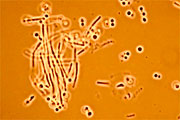- Number 332 |
- March 7, 2011
Combatting antibiotic resistant bacteria: it's all in the genes

LLNL scientists have found
a way to combat antibiotic
resistant bacteria by using the
bacteria's own genes.
Researchers at Lawrence Livermore National Laboratory (LLNL) have discovered a new way to combat antibiotic resistant bacteria by using the bacteria's own genes.
Despite the advances made to antibiotics over the last 50 years, the list of antibiotic resistant bacteria, such as MRSA (Methicillin-resistant Staphylococcus aureus), E.coli, Salmonella and Campylobacter, is growing and becoming one of the world's most serious health concerns.
That's where bio-scientist Paul Jackson and his LLNL team come in. The group has taken a new approach to combating antibiotic resistant bacteria by developing a new generation of antibiotics using genetic analysis to turn the pathogens' own genes and processes against it.
